Related Research Articles

The beagle is a breed of small scent hound, similar in appearance to the much larger foxhound. The beagle was developed primarily for hunting hare, known as beagling. Possessing a great sense of smell and superior tracking instincts, the beagle is the primary breed used as a detection dog for prohibited agricultural imports and foodstuffs in quarantine around the world. The beagle is intelligent and is a popular pet due to its size, good temper, and a lack of inherited health problems.

The Basenji is a breed of hunting dog. It was bred from stock that originated in central Africa. The Fédération Cynologique Internationale places the breed in the Spitz and primitive types. The Basenji produces an unusual yodel-like sound, due to its unusually shaped larynx. This trait also gives the Basenji the nickname the 'barkless dog.'

Canidae is a biological family of dog-like carnivorans, colloquially referred to as dogs, and constitutes a clade. A member of this family is also called a canid. The family includes three subfamilies: the extant Caninae and the extinct Borophaginae and Hesperocyoninae. The Caninae are known as canines, and include domestic dogs, wolves, coyotes, foxes, jackals and other extant and extinct species.
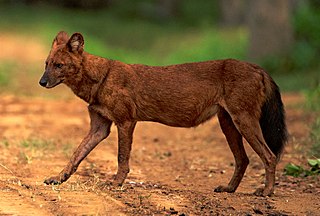
The dhole is a canid native to Central, South, East and Southeast Asia. Other English names for the species include Asian wild dog, Asiatic wild dog, Indian wild dog, whistling dog, red dog, red wolf, and mountain wolf. It is genetically close to species within the genus Canis, but distinct in several anatomical aspects: its skull is convex rather than concave in profile, it lacks a third lower molar and the upper molars sport only a single cusp as opposed to between two and four. During the Pleistocene, the dhole ranged throughout Asia, Europe and North America but became restricted to its historical range 12,000–18,000 years ago.

The wolf, also known as the gray wolf or grey wolf, is a large canine native to Eurasia and North America. More than thirty subspecies of Canis lupus have been recognized, including the dog and dingo, though gray wolves, as popularly understood, only comprise naturally-occurring wild subspecies. The wolf is the largest extant member of the family Canidae, and is further distinguished from other Canis species by its less pointed ears and muzzle, as well as a shorter torso and a longer tail. The wolf is nonetheless related closely enough to smaller Canis species, such as the coyote and the golden jackal, to produce fertile hybrids with them. The wolf's fur is usually mottled white, brown, gray, and black, although subspecies in the arctic region may be nearly all white.

The dingo is an ancient (basal) lineage of dog found in Australia. Its taxonomic classification is debated as indicated by the variety of scientific names presently applied in different publications. It is variously considered a form of domestic dog not warranting recognition as a subspecies, a subspecies of dog or wolf, or a full species in its own right.

The Call of the Wild is a short adventure novel by Jack London, published in 1903 and set in Yukon, Canada, during the 1890s Klondike Gold Rush, when strong sled dogs were in high demand. The central character of the novel is a dog named Buck. The story opens at a ranch in Santa Clara Valley, California, when Buck is stolen from his home and sold into service as a sled dog in Alaska. He becomes progressively more primitive and wild in the harsh environment, where he is forced to fight to survive and dominate other dogs. By the end, he sheds the veneer of civilization, and relies on primordial instinct and learned experience to emerge as a leader in the wild.

A wolfdog is a canine produced by the mating of a domestic dog with a gray wolf, eastern wolf, red wolf, or Ethiopian wolf to produce a hybrid.

The brown hyena, also called strandwolf, is a species of hyena found in Namibia, Botswana, western and southern Zimbabwe, southern Mozambique and South Africa. It is the only extant species in the genus Parahyaena. It is currently the rarest species of hyena. The largest remaining brown hyena population is located in the southern Kalahari Desert and coastal areas in Southwest Africa. The global population of brown hyena is estimated by IUCN at a number between 4,000 and 10,000 and its conservation status is marked as near threatened in the IUCN Red List.
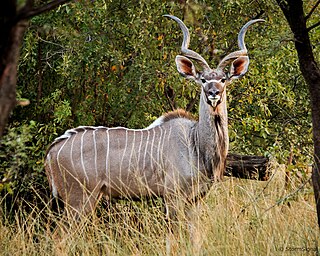
The kudus are two species of antelope of the genus Tragelaphus:
Ticos is a colloquial name for the natives of Costa Rica.
Dog Whisperer with Cesar Millan is a reality television series that featured dog trainer Cesar Millan's work with problem dogs. After nine seasons, the series ran from September 13, 2004 to September 15, 2012.

César Felipe Millán Favela is a Mexican-American dog trainer. He is widely known for his Emmy-nominated television series Dog Whisperer with Cesar Millan, which was produced from 2004 to 2012 and is broadcast in more than 80 countries worldwide.

The black dog is a supernatural, spectral, or demonic entity originating from English folklore that has also been seen throughout Europe and the Americas. It is usually unnaturally large with glowing red or yellow eyes, is often connected with the Devil, and is sometimes an omen of death. It is sometimes associated with electrical storms, and also with crossroads, barrows, places of execution and ancient pathways.
Shaun Ellis is a British animal researcher who lived among wolves, and adopted a pack of abandoned North American timber wolf pups. He is the founder of Wolf Pack Management and is involved in a number of research projects in Poland and at Yellowstone National Park in the United States.
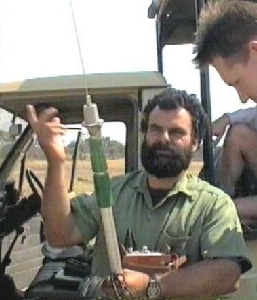
Greg Rasmussen is a 2023 Indianapolis Prize nominee and wildlife conservation biologist who has studied the critically endangered painted dog, previously known as the African wild dog, for over thirty years, one of the longest studies of the species ever conducted. Working in the Hwange National Park area in Zimbabwe, he is the founder and executive directorof Painted Dog Research Trust (PDRT) whose mission is to both continue with research into the species and build for the future of conservation by meaningfully incorporating Zimbabwean students to develop local capacity and tomorrow’s conservationists. His work has proven successful with the national pack size doubling thanks to these dedicated efforts. He is also the founder and a former director of the Painted Dog Conservation (PDC) project in Zimbabwe which grew to be a model for conservation, incorporating antipoaching, community outreach, and child conservation education, developing long-term community conservation.
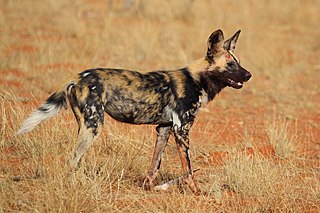
The African wild dog, also known as the painted dog or Cape hunting dog, is a wild canine native to sub-Saharan Africa. It is the largest wild canine in Africa, and the only extant member of the genus Lycaon, which is distinguished from Canis by dentition highly specialised for a hypercarnivorous diet, and by a lack of dewclaws. It's estimated that there are around 6,600 adults living in 39 subpopulations that are all threatened by habitat fragmentation, human persecution, and outbreaks of disease. As the largest subpopulation probably comprises fewer than 250 individuals, the African wild dog has been listed as endangered on the IUCN Red List since 1990.
The Botswana Predator Conservation Trust (BPCT), formerly called the Botswana Wild Dog Research Project in 1989, expanded from addressing wild dog conservation to cover all the large carnivore species in Botswana.

Painted Dog Conservation was founded in 1992 by wildlife conservation biologist Greg Rasmussen for the protection of the painted dogs and their habitat. Painted Dog Conservation works to engage and incorporate local communities in protecting painted dogs in Zimbabwe. The painted dog, or African wild dog, was once common in Africa with estimates of over half a million spread among 39 countries. Current estimates put their numbers at about 3,000 only found in Tanzania, Zambia, Mozambique, Zimbabwe, Botswana and South Africa. Since PDC's creation, Zimbabwe's wild dog population has increased from 400 to 700 individuals. Painted Dog Conservation is partnered with the Wildlife Conservation Network.
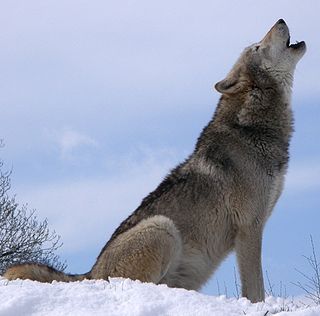
Howling is a vocal form of animal communication seen in most canines, particularly wolves, coyotes, foxes, and dogs, as well as cats and some species of monkeys. Howls are lengthy sustained sounds, loud and audible over long distances, often with some variation in pitch over the length of the sound. Howling is generally used by animals that engage in this behavior to signal their positions to one another, to call the pack to assemble, or to note their territory. The behavior is occasionally copied by humans, and has been noted to have varying degrees of significance in human culture.
References
- ↑ Marshall, Leon (11 March 2004). "Wild Dog Urine May Be Used as "Fences" in Africa". National Geographic News.
- ↑ "Good Dogs, Bad Dogs: African Wild Dogs in Developing Rural Africa". Houston Zoo. Retrieved 2008-05-28.
- ↑ McNutt, John; et al. (1996). Running Wild: Dispelling the Myths of the African Wild Dog. Smithsonian Institution Press. p. 149. ISBN 1-56098-717-0.